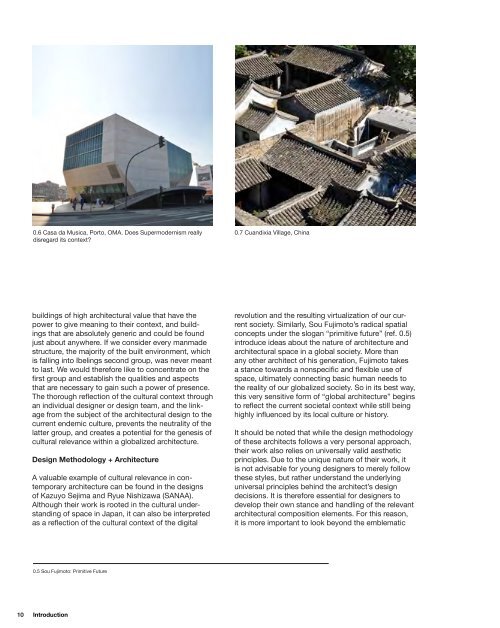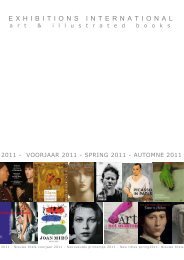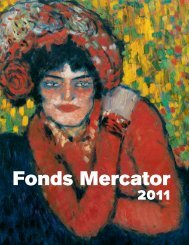Contemporary Design Methods in Architecture - exhibitions ...
Contemporary Design Methods in Architecture - exhibitions ...
Contemporary Design Methods in Architecture - exhibitions ...
You also want an ePaper? Increase the reach of your titles
YUMPU automatically turns print PDFs into web optimized ePapers that Google loves.
10<br />
0.6 Casa da Musica, Porto, OMA. Does Supermodernism really<br />
disregard its context?<br />
build<strong>in</strong>gs of high architectural value that have the<br />
power to give mean<strong>in</strong>g to their context, and build<strong>in</strong>gs<br />
that are absolutely generic and could be found<br />
just about anywhere. If we consider every manmade<br />
structure, the majority of the built environment, which<br />
is fall<strong>in</strong>g <strong>in</strong>to Ibel<strong>in</strong>gs second group, was never meant<br />
to last. We would therefore like to concentrate on the<br />
first group and establish the qualities and aspects<br />
that are necessary to ga<strong>in</strong> such a power of presence.<br />
The thorough reflection of the cultural context through<br />
an <strong>in</strong>dividual designer or design team, and the l<strong>in</strong>kage<br />
from the subject of the architectural design to the<br />
current endemic culture, prevents the neutrality of the<br />
latter group, and creates a potential for the genesis of<br />
cultural relevance with<strong>in</strong> a globalized architecture.<br />
<strong>Design</strong> Methodology + <strong>Architecture</strong><br />
A valuable example of cultural relevance <strong>in</strong> contemporary<br />
architecture can be found <strong>in</strong> the designs<br />
of Kazuyo Sejima and Ryue Nishizawa (SANAA).<br />
Although their work is rooted <strong>in</strong> the cultural understand<strong>in</strong>g<br />
of space <strong>in</strong> Japan, it can also be <strong>in</strong>terpreted<br />
as a reflection of the cultural context of the digital<br />
0.5 Sou Fujimoto: Primitive Future<br />
Introduction<br />
0.7 Cuandixia Village, Ch<strong>in</strong>a<br />
revolution and the result<strong>in</strong>g virtualization of our current<br />
society. Similarly, Sou Fujimoto’s radical spatial<br />
concepts under the slogan “primitive future” (ref. 0.5)<br />
<strong>in</strong>troduce ideas about the nature of architecture and<br />
architectural space <strong>in</strong> a global society. More than<br />
any other architect of his generation, Fujimoto takes<br />
a stance towards a nonspecific and flexible use of<br />
space, ultimately connect<strong>in</strong>g basic human needs to<br />
the reality of our globalized society. So <strong>in</strong> its best way,<br />
this very sensitive form of “global architecture” beg<strong>in</strong>s<br />
to reflect the current societal context while still be<strong>in</strong>g<br />
highly <strong>in</strong>fluenced by its local culture or history.<br />
It should be noted that while the design methodology<br />
of these architects follows a very personal approach,<br />
their work also relies on universally valid aesthetic<br />
pr<strong>in</strong>ciples. Due to the unique nature of their work, it<br />
is not advisable for young designers to merely follow<br />
these styles, but rather understand the underly<strong>in</strong>g<br />
universal pr<strong>in</strong>ciples beh<strong>in</strong>d the architect’s design<br />
decisions. It is therefore essential for designers to<br />
develop their own stance and handl<strong>in</strong>g of the relevant<br />
architectural composition elements. For this reason,<br />
it is more important to look beyond the emblematic










![01 -[BE/INT-2] 2 KOL +UITGEV+ - exhibitions international](https://img.yumpu.com/19621858/1/184x260/01-be-int-2-2-kol-uitgev-exhibitions-international.jpg?quality=85)






